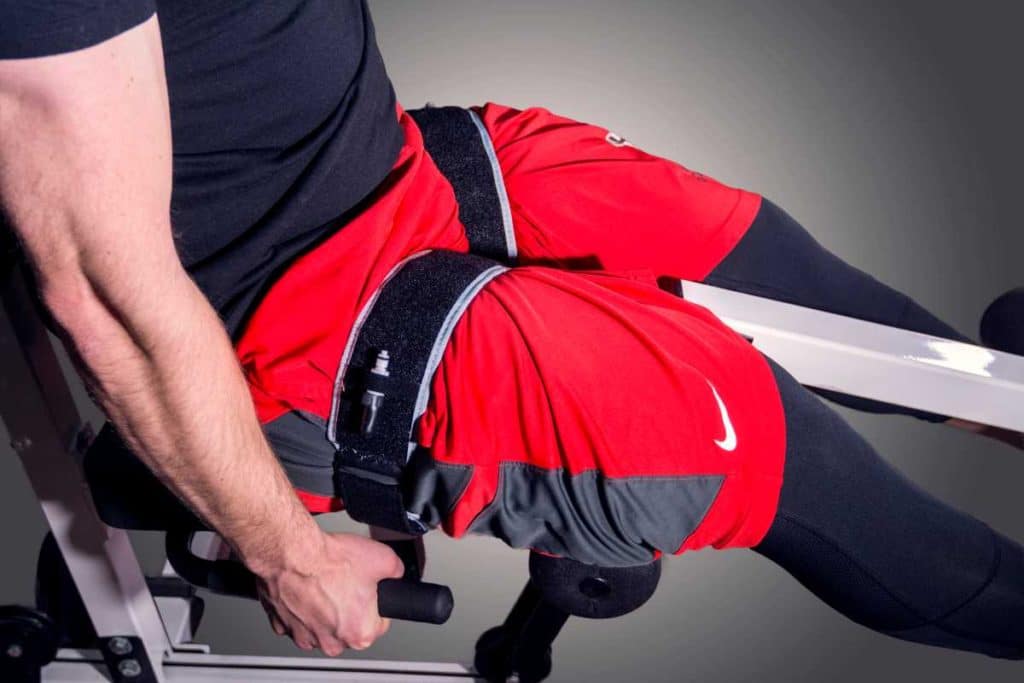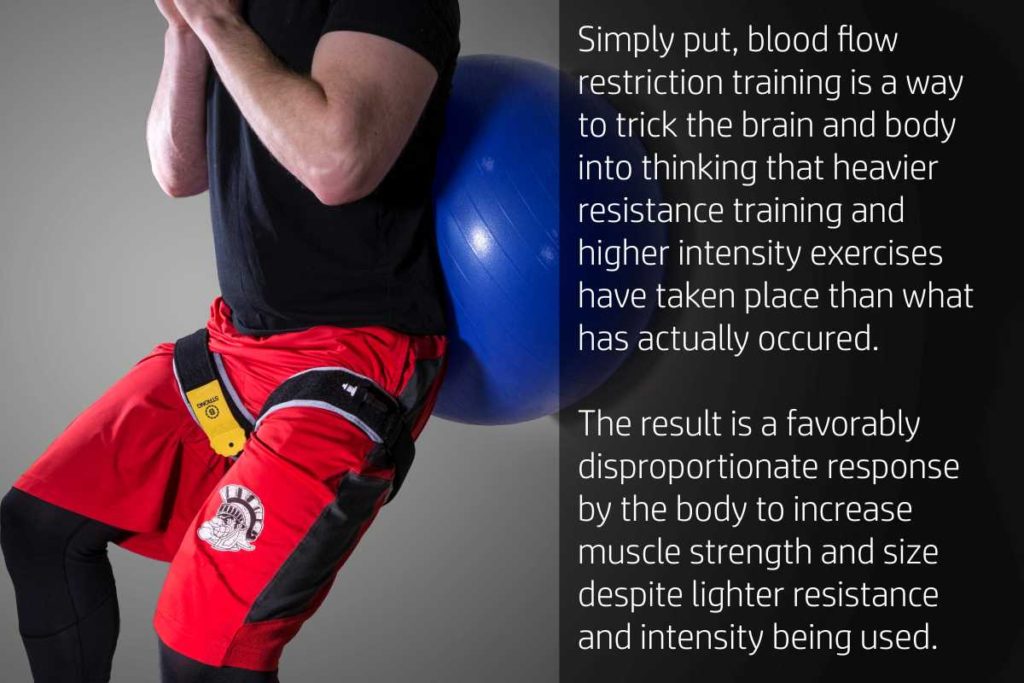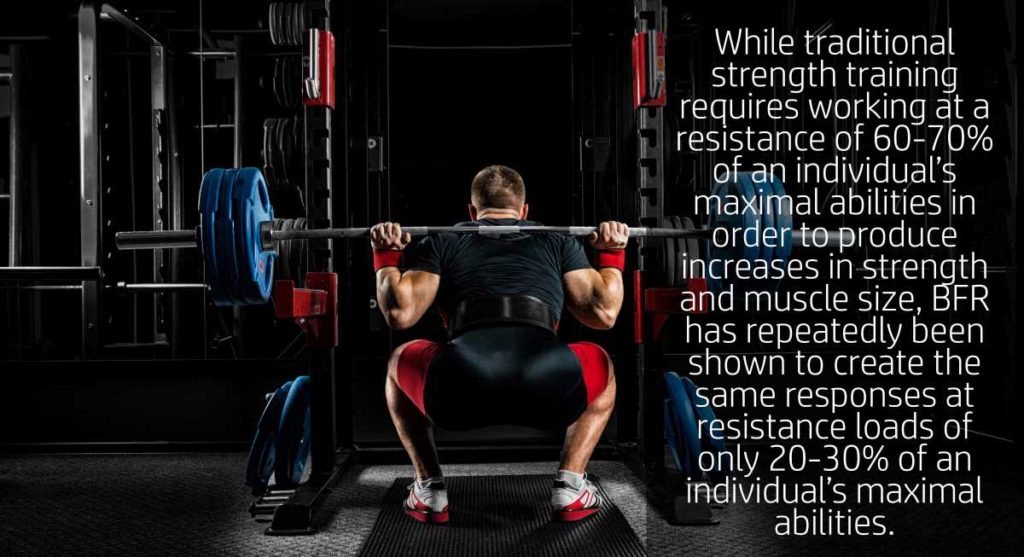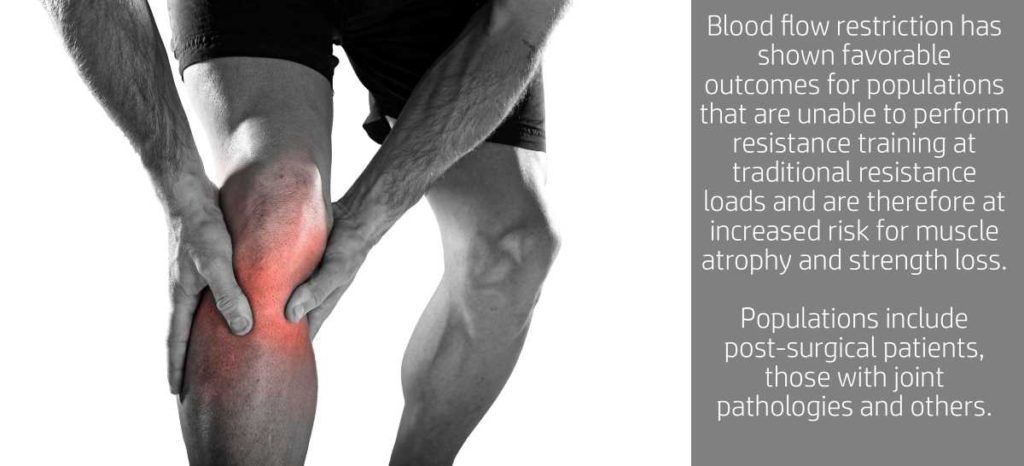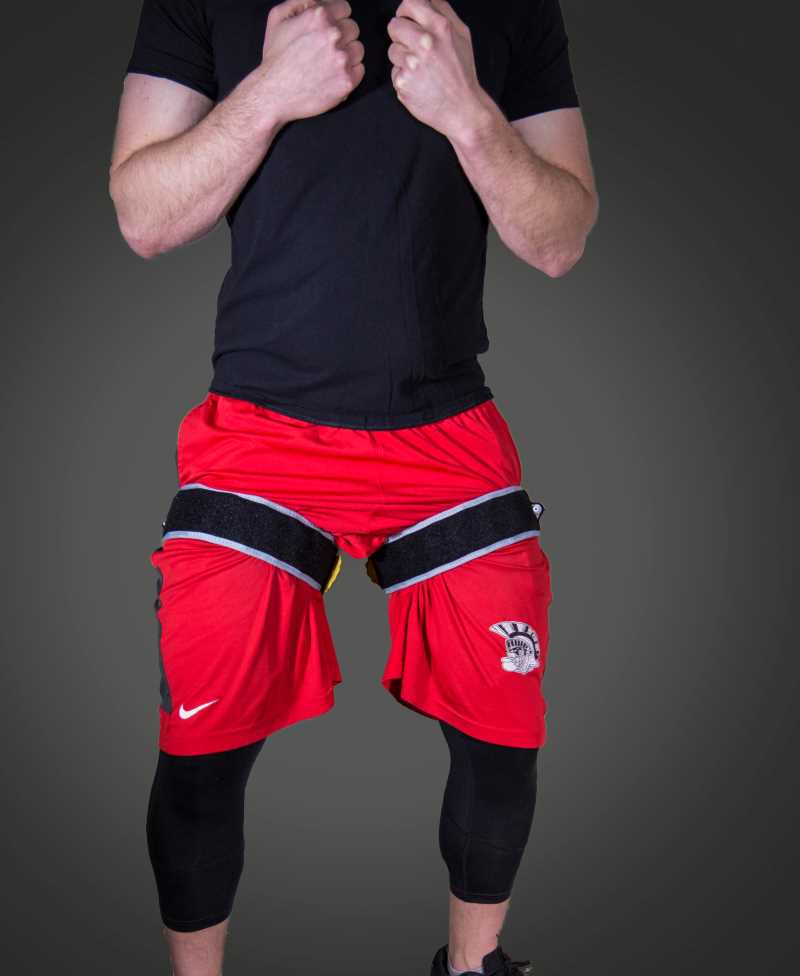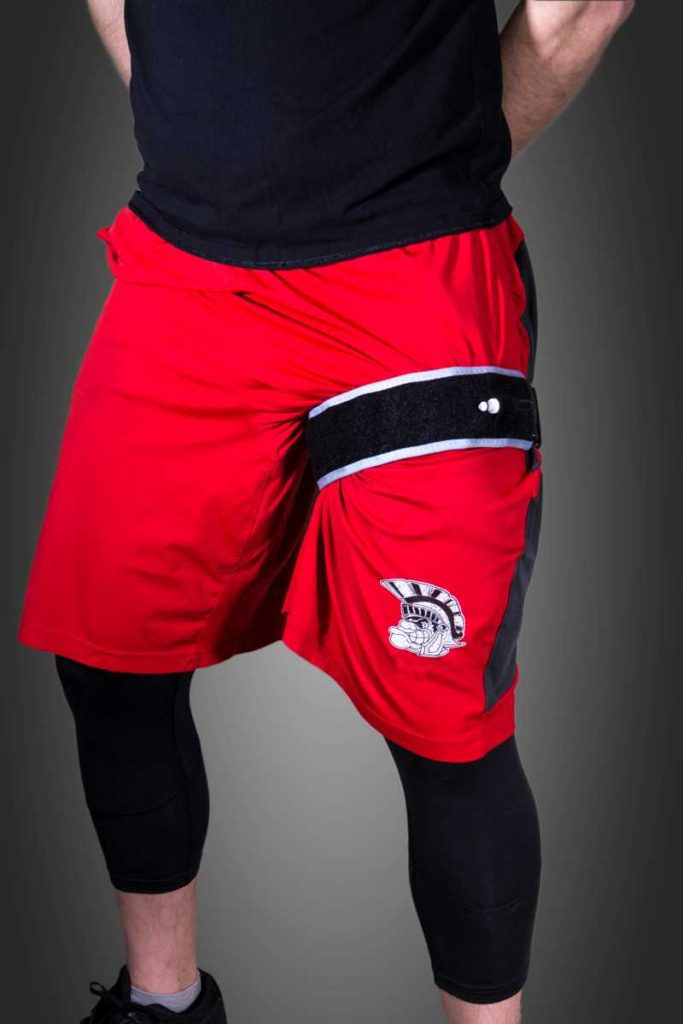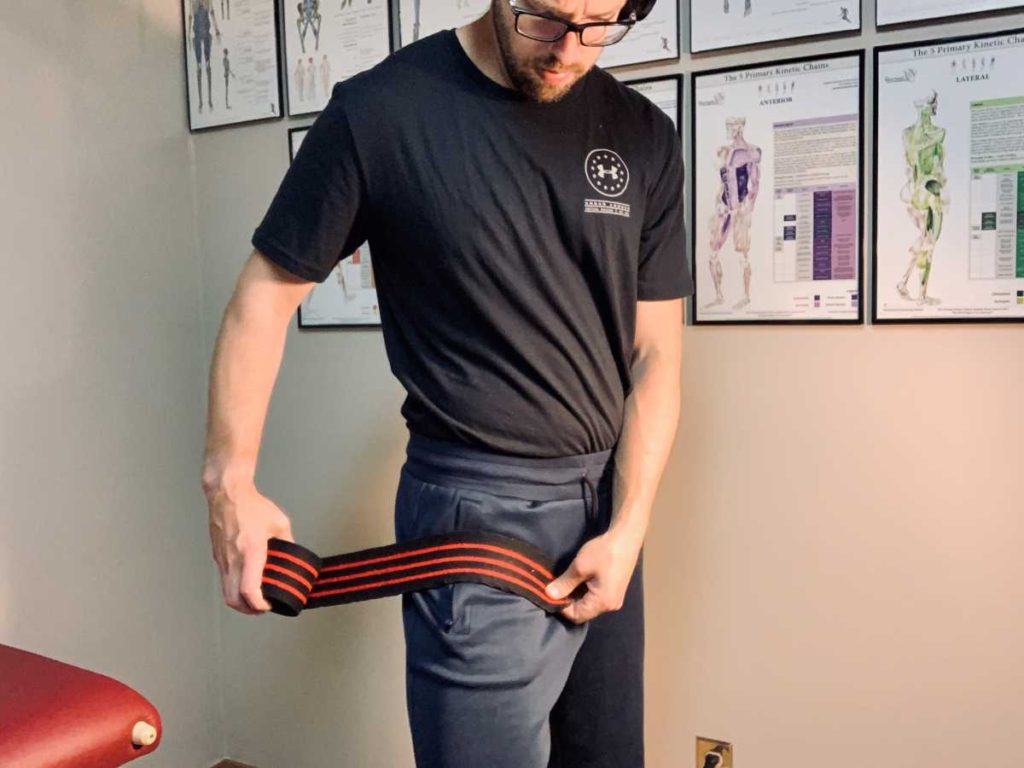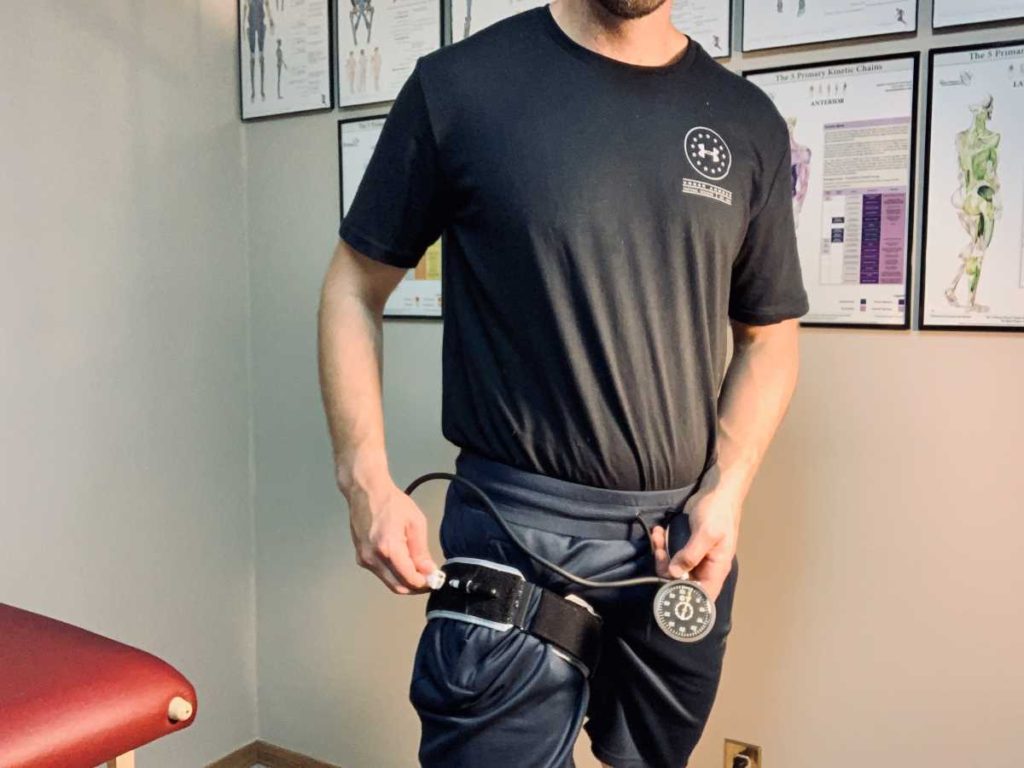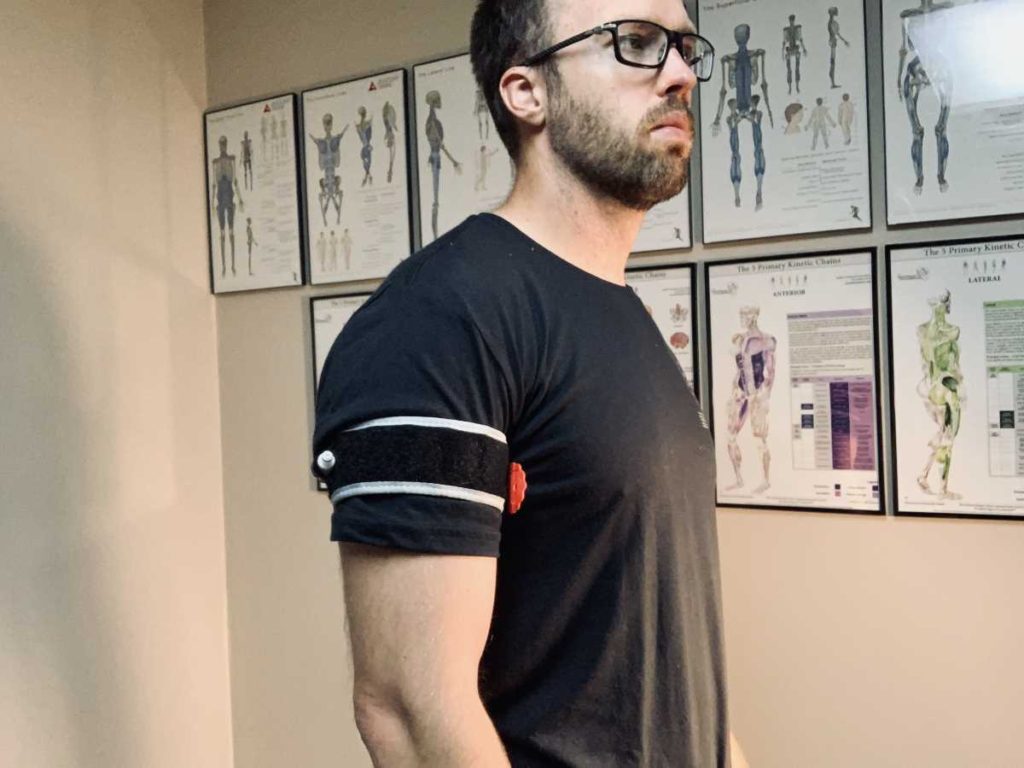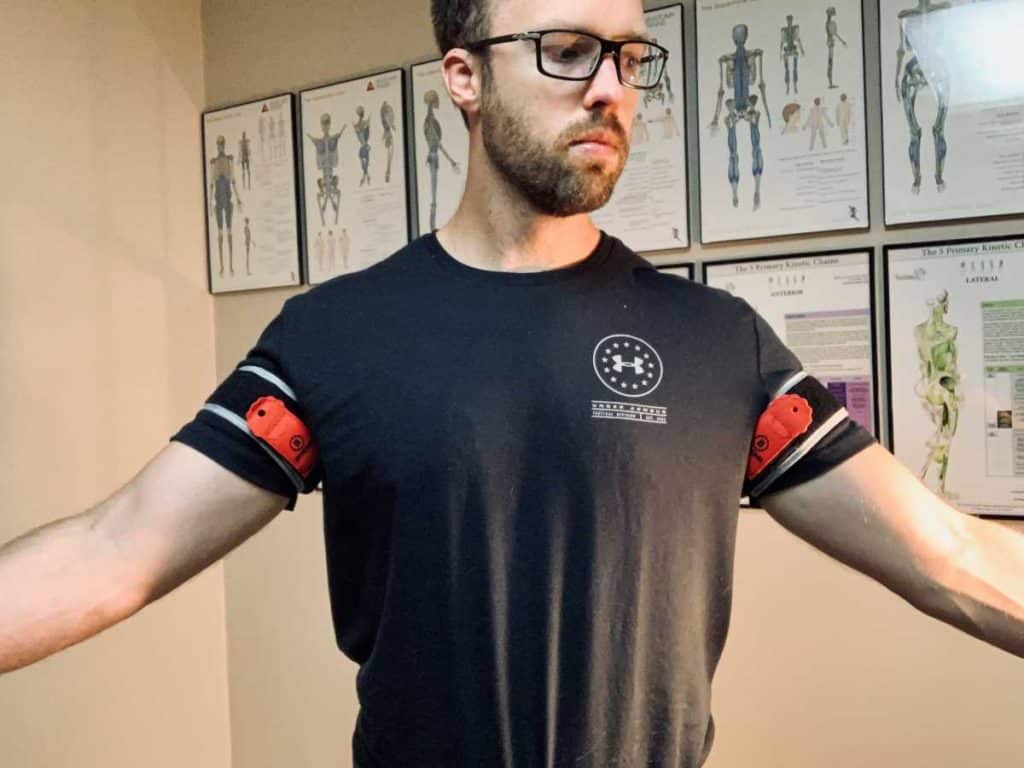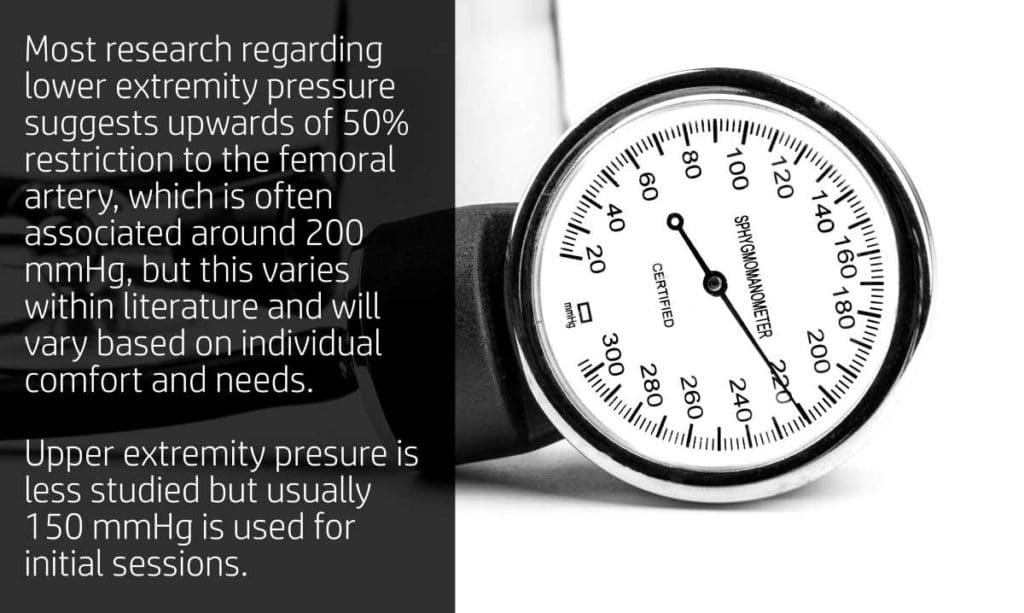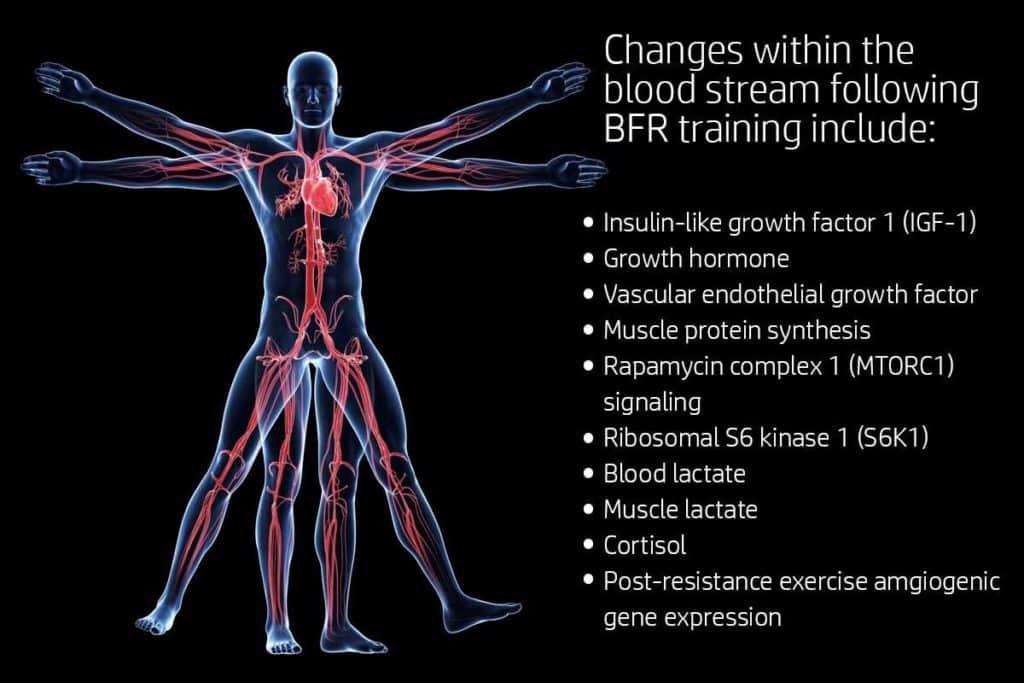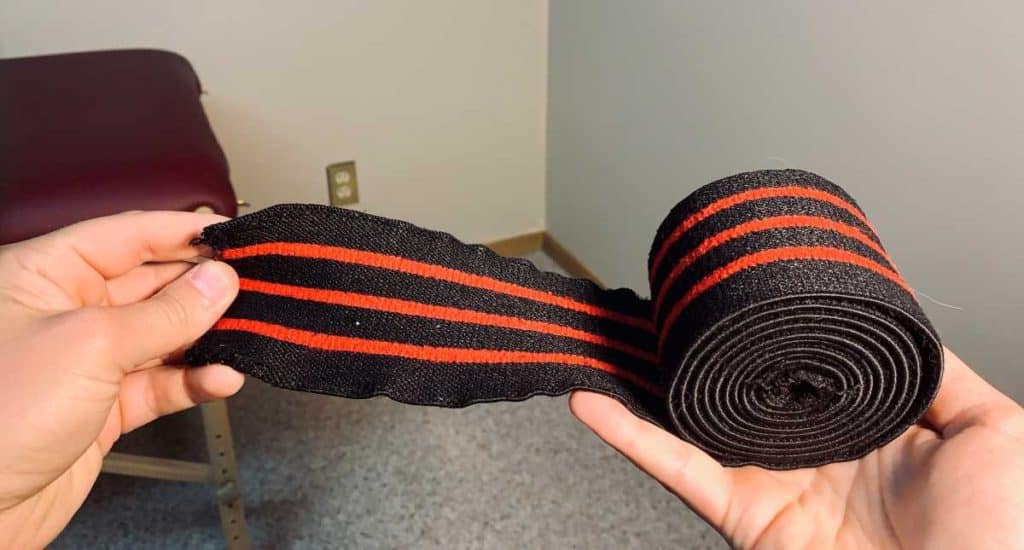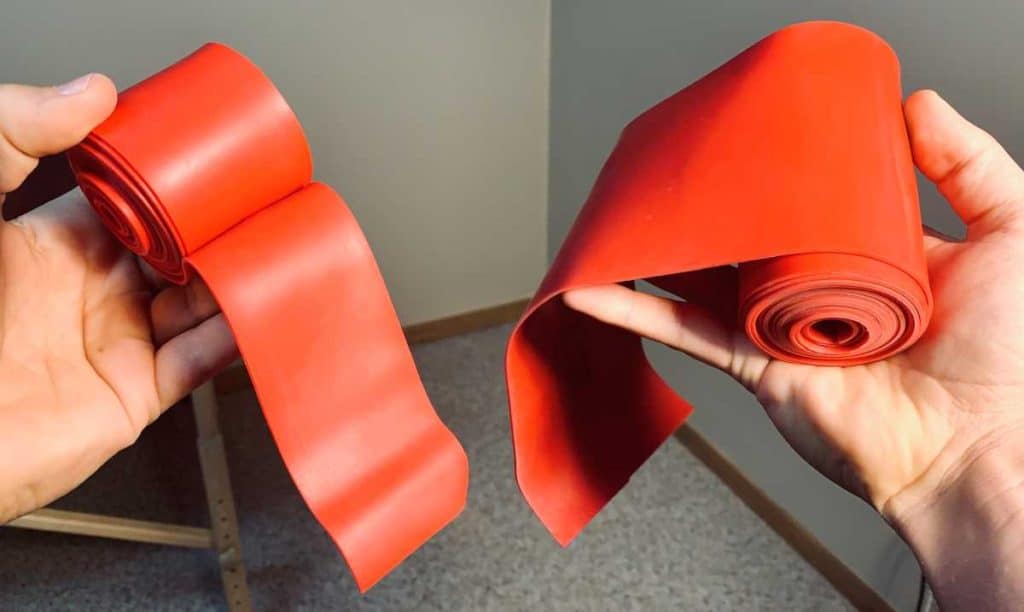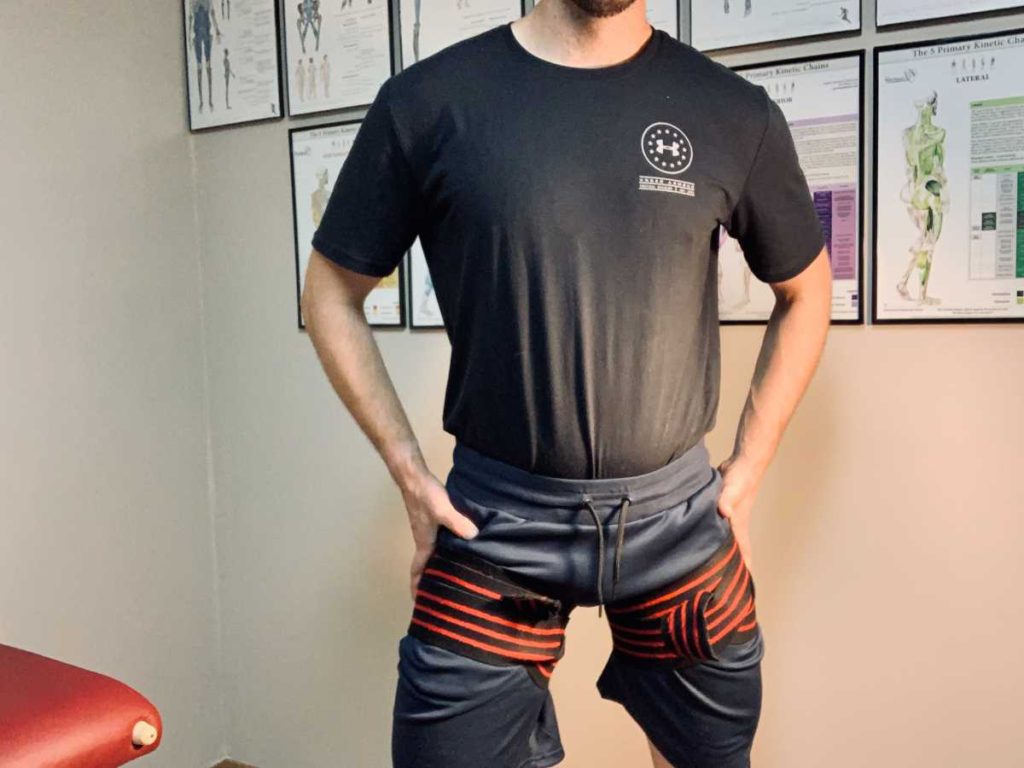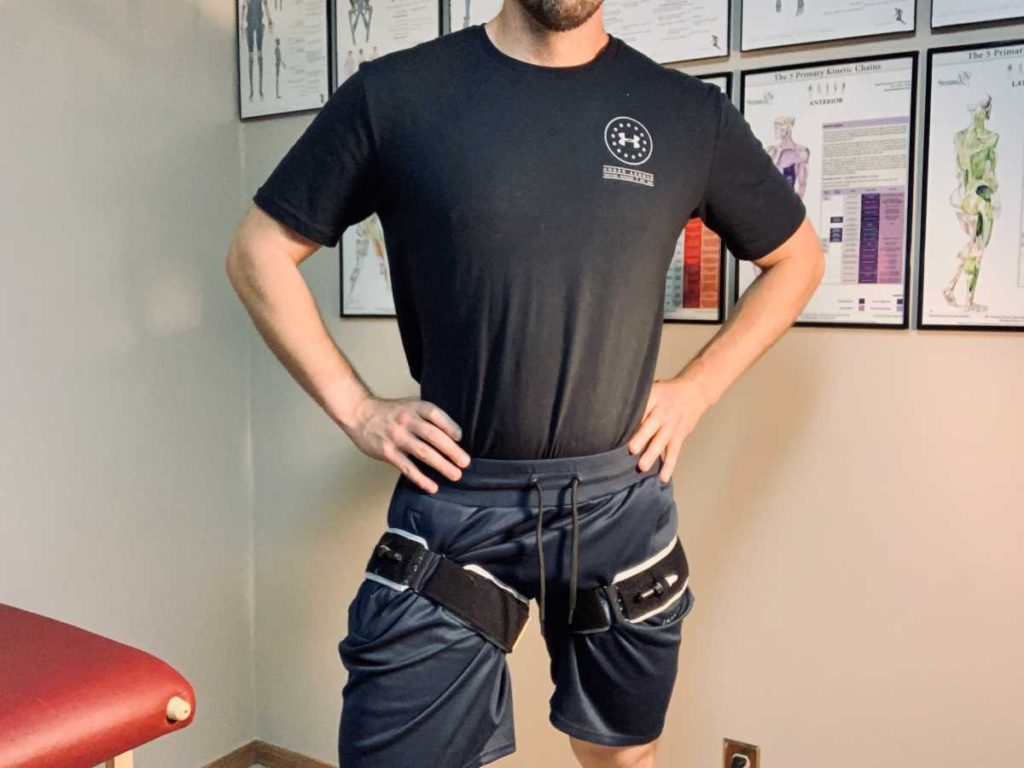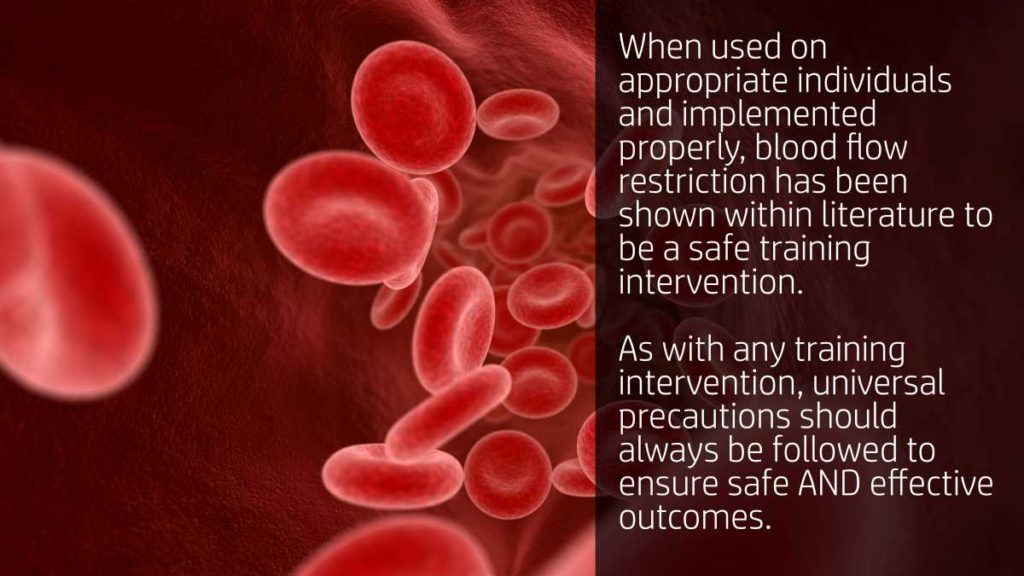Note: If you’re interested in knowing the research behind the efficacy of blood flow restriction for clinical populations and therapeutic purposes, be sure to check out my article: Blood Flow Restriction: Evidence and Uses For Injury Rehabilitation, where I provide an overview (consisting of large amount of findings within literature) towards using BFR within the clinic.
Also, this article you’re reading right now is rather lengthy – so make sure to bookmark it, as you’ll likely want to come back to it rather than read it all in one sitting. I’ve included a number of academic studies at the end of this post in case you’d like further specifics of what the science has found.
Introduction & the quick takeaway of this article
Back in early 2018, I became fascinated with the concept of utilizing blood flow restriction (BFR) therapy within rehabilitative settings. Ever since then I have researched it extensively (including my sixty-two page Critically Appraised Topic academic paper to cap off PT school) and have utilized it for myself as well as patients under a variety of settings.
This article will cover a detailed description pertaining to blood flow restriction training/therapy, the nature of why and how it’s used as well as other key features and components of this highly effective intervention.
While blood flow restriction therapy has only recently become more mainstream within the rehabilitative setting, there is a high body of scientific evidence that supports its efficacy for enhancing strength and size (often referred to as muscle hypertrophy, or cross-sectional area) of skeletal muscle fibers. This evidence exists for demographics who are young, elderly, healthy and those who have specific orthopedic issues within their body.
Blood flow restriction training can therefore be a highly effective adjunct in healthy populations and within the rehabilitative setting when used appropriately.
If you would like to learn more about the blood flow restriction system that I use for myself as well as on my patients, you can check out this page on my website: My Recommended BFR System. I have a 10% discount code on that page that you can use for any purchases from the company.
The quick overview of the topics within this article:
- What exactly is blood flow restriction training and how does it work?
- How is blood flow restriction training different than traditional strength training?
- How can patients within the clinic benefit from using blood flow restriction?
- How is blood flow restriction training or therapy performed?
- Which populations has it been studied on?
- The Specifics: how exactly does blood flow restriction work to achieve its results?
- What are the specific types of cuffs to effectively and safely restrict blood flow into or out of the extremities?
- How often and for how long must one use blood flow restriction before results are evident?
- Is blood flow restriction safe to perform?
- Concluding remarks
What exactly is blood flow restriction training and how does it work?
Blood flow restriction training or therapy (depending on the population it is being used for) is a form of strength training used across a variety of populations with the primary goal of increasing muscle strength and/or muscle size. What makes it so unique and promising is that it requires much less mechanical stress on the muscles, tendons, bones and joints than what is required with traditional strength training methods.
By “mechanical stress” I’m simply referring to the amount of weight or resistance that an individual has to push, pull or lift during an exercise. Traditionally, making muscles become bigger and/or stronger requires them to work more towards the upper end of their capabilities during an exercise. With blood flow restriction however, individuals can make their muscles bigger and/or stronger during exercise without the muscles needing to work more towards this upper end of their abilities.
Blood flow restriction therapy is therefore often used for individuals who cannot perform resistance training with traditional loads (weights) due to limiting factors such as pain, physical muscle weakness, structural weakness of bones, joints or other tissues.
Blood flow restriction training is also used by non-injured individuals (athletes, bodybuilders, etc.) who wish to improve strength and/or muscle size while sparing their muscles and/or joints to repeatedly heavy resistance loads. It can also help in sparing the central nervous system of incurring fatigue from chronically heavy lifting.
How is blood flow restriction training different than traditional strength training?
Here’s the amazing thing about BFR training/rehabilitation: individuals who partake in a regular resistance training routine while using BFR interventions can in fact elicit the same extent of increases in muscle strength and muscle size while only lifting around 20 – 30% of their normal maximal abilities. 1–7
If that doesn’t strike you as profoundly beneficial for a variety of reasons, let me be clear in saying that in order for an individual to elicit noticeable changes in muscle size and force output, traditional strength training needs to be performed around 70% of an individual’s maximal abilities. 8,9
So, as an example, if the maximal weight you could squat was 200 pounds, in order to increase muscle size and strength within your legs using traditional strength training methods, you’d need be be performing your squats somewhere around the 150-160 pound range. Note that you would need to of course be using appropriate sets and repetitions when using that weight in order to give your muscles the stimulation that they would need in order to make this happen.
But if using blood flow restriction cuffs (specifics of cuffs and how to use them will be discussed later within this article), the science is showing us that you could elect the same muscle size and strength increases by only squatting around the 40-60 pound range (20-30% of your maximal abilities) with appropriate sets and repetitions being performed. 1–7
Are you beginning to see the applications of how it could be of benefit to the appropriate populations within the rehabilitative setting and how it could be an effective training method for healthy athletes as well?
How can patients within the clinic benefit from using blood flow restriction?
I have written an extensive blog post covering this very topic. If you would like to get the in-depth breakdown pertaining to the various facets of this question, you can do so by clicking the link to my other blog post: Blood Flow Restriction: Evidence and Uses For Injury Rehabilitation.
Here’s the readers digest version of that post:
The evidence is quite favorable when it comes to BFR being an effective strengthening intervention for specific post-surgical populations, elderly populations and those with specific joint pathologies (osteoarthritis, in particular).2,3,10–17
When an individual is incapable of performing movements or exercises around the required 70% of their maximal abilities (either due to having too much pain or excessive neuromuscular weakness), they essentially can’t stimulate those muscles adequately enough to trigger new muscle growth and strength. 18,19 It therefore becomes incredibly difficult for these individuals to strengthen those muscles. This inability to generate adequate amounts of functional strength can lead to further impairments in functional abilities, increases in pain and even a decreased quality of life. 20–25
For some patients, the inability to load their muscles with heavy resistance is only temporary (but still takes many months before being able to do so), such as when coming out of surgery for an ACL reconstruction. For others such as those with osteoarthritis within their knees or other joints, the inability to load their muscles with heavier resistance is a more permanent issue (due to persistent pain arising within those joints whenever they are stressed or loaded beyond a certain extent).
When muscles cannot be challenged (stimulated) appropriately, they can atrophy (reduce in size), which leads to weakness and potentially predisposes the individual to higher risk of injury, pain or other complications. The individual then become weaker and the vicious cycle is then set in place.
When it comes to post-surgical patients, the more quickly a high-loading and high-intensity exercise can be appropriately mimicked (through BFR training), the less muscle atrophy and strength loss a patient will experience during their rehabilitation.18,26 This leads to quicker recovery and thus quicker return to the activity that the individual wants to partake in or get back into.
For individuals with chronic pathologies (such as osteoarthritis), mimicking high-loading and high-intensity exercises serves as a way to improve muscle strength and muscle size when traditional strengthening protocols would otherwise be too painful on the joints to do so.11,16,27–30
Of course BFR is not an intervention that is appropriate for every patient and choosing to implement it always needs to be preceded by clinical reasoning and other unique factors. But for those who are at risk of developing sarcopenia (loss of muscle tissue), muscle atrophy (loss of muscle size) or who simply cannot tolerate heavier loads during exercise, blood flow restriction can be a very beneficial intervention.
How is blood flow restriction training or therapy performed?
Simply put, blood flow restriction therapy/training involves placing a restrictive cuff around the arm(s) and/or leg(s) (depending on the extremity that is being trained or rehabbed) with a predetermined amount of circumferential tension pressing onto the limb. This in turn limits blood flow out of the limb (some blood flow into the limb is limited as well).
During this time of impeded venous blood flow return (blood within the veins of the extremity that is trying to make its way back to the heart), the individual performs volitional movement/exercise(s) against a predetermined load/resistance. In other words, they perform resistance exercise(s) all while the cuff is applying a preset amount of pressure around the limb(s).
The cuff and its subsequent pressure is kept on during rest breaks between exercise sets, allowing the metabolic environment within the blood to continually to build. Normally these metabolites that build up during an exercise are somewhat flushed out of the muscles within the exercised limb between rest sets and are carried away in the bloodstream back towards the heart.
But in the case of BFR, these metabolites continue to build within the limb, creating an inability for the muscles within the limb(s) to effectively recover. This results in much greater fatigue to the muscles (both during the exercise sets and reps that still must be performed as well as after the training/therapy session has been completed in its entirety).31,32
It’s important to note that there’s no universal protocol or set of protocols pertaining to the various facets of implementing a BFR regimen. However, there are some pretty good guidelines that have been widely used and discovered throughout literature. So, let’s have a look:
How many sets, reps and exercises should be performed?
There’s an entire world to be examined here, but for the sake of this article, it’s worth knowing that the most common protocol for sets and reps is the 30/15/15/15 protocol while using around 20-30% of the individual’s maximal loading abilities.14–16,33 These numbers refer to the number of repetitions performed within a single set for a given exercise. In between each set, a strict 30-second rest break is given.
The first set is 30 repetitions, while the following three sets are each 15 repetitions a piece. These higher repetitions help to really establish the metabolic environment within the extremities that allows BFR to elicit its favorable responses.
In regards to how many exercises should be performed, it varies largely based on the individual’s overall status (fitness, injury condition, state of rehabilitation, etc). Often starting out with a single exercise can be ideal and as the individual progresses and adapts, a second exercise can be given followed by a third, etc. Clinical reasoning along with the patient’s specific characteristics and situation must be applied and considered as they are of paramount importance for both safety and efficacy.
As a general rule, the number of exercises that an individual wishes to perform should all be completed in under 20 minutes, as keeping cuffs on longer than this may not be ideal.
Are certain exercises better than others when performing blood flow restriction?
The major takeaway to know here is that while exercise selection will depend on a variety of patient factors (injury type, injury status, patient comfort, and so on,) the most ideal exercise/movement to do strictly from a BFR efficacy standpoint are ones that create the greatest metabolically favourable environment within the limb(s). These tend to be compound movements (movements involving multiple joints, and thus more muscles within the exercise). This equates to greater volume of muscle recruitment/usage, and therefore greater metabolic buildup within the blood and the muscles itself.
Where are the cuffs placed when performing BFR exercises?
When it comes to performing BFR on the lower extremity, the cuffs are most often placed just below the gluteal fold (just below the butt cheek). This location works quite well since it doesn’t interfere with movement too much while also restricting a larger amount of blood flow from the extremity.
For the upper extremity, cuffs are most often placed as high up on the arm as comfortably possible. There are some key things to keep in mind with this, however; there’s a large neurovascular bundle (a collection of nerves and blood vessels) up within this region on the front side of the body and some individuals can be rather susceptible to pressure in this region, which can result in altered sensation running down into the arm. This can show up as the classic “pins and needles” feeling down into the arm and/or hand along with some degree of numbness. This is a form of acute neuropraxia, which in this context is a fancy term for the pins and needles sensation we can feel when our limb “falls asleep”.
How much restriction pressure around the limb are we talking about here?
Again, there’s no universal rule for how much pressure or restriction should be used with the cuffs in order to produce “ideal” results. What IS universal though is the fact that you never want to fully occlude (cut off) blood flow entirely. Aside from this being extremely uncomfortable, it is also incredibly dangerous.
Most research regarding lower extremity pressure suggests upwards of 50% restriction to the femoral artery, which is often associated around 200 mmHg, but again this varies within literature and will also vary based on individual tolerances and needs.34
In regards to the upper extremity, again there is no set value within literature and the upper extremity has been studied less than the lower extremity. 150 mmHg of pressure seems to be beneficial, or approximately 130% of the individual’s systolic blood pressure. 34
Most individuals are surprised at just how minimal this pressure actually feels. It doesn’t feel like an excessive or highly restrictive amount. Assuming appropriate cuff pressure, you should be able to wear the cuffs for up to twenty minutes without high levels of discomfort (exercise will likely increase the discomfort as more and more sets and exercises are performed).
Cuffs that are worn with too much compression when exercising will lead to an uncomfortable cramping of the muscles beneath the cuffs. If this happens, the pressure should be reduced in order to alleviate the cramping and improve comfort.
Which populations has blood flow restriction been studied on?
Research has conducted studies on various populations and demographics. It has been studied (and shown to be effective) on healthy and pathological (injured) men and women ranging from college-age to elderly, along with athletic and non-athletic populations.6,35–38
The Specifics: how exactly does blood flow restriction work to achieve its results?
In essence, BFR works by essentially tricking the brain into thinking that the body has performed much heavier resistance exercise and higher intensity work than what has actually taken place. As a result, the brain releases a hormonal response that is disproportionality favorable to the individual who has completed the BFR exercise(s).
In a very basic sense, BFR training inundates the brain and body with high volumes or concentrations of metabolites within the blood that have been built up during the exercise(s) due to the restricted outflow of blood from the extremities.31,32 These high volumes or concentrations of metabolites typically only fill the body to the same extent when traditional, heavier and higher intensity exercise has been performed. Therefore, when the brain and body are exposed to these high concentrations, they both take action by eliciting responses they believe are appropriate to what they think has just taken place.
While researchers still aren’t entirely sure of the exact mechanisms that occur in order for all these changes to take place, there is a lot that the scientific community has come to understand over the last decade. So, the exact physiology behind how it all works is currently being investigated, but there is literature out there supporting statistically significant changes in within the blood such as insulin-like growth factor 1 (IFG-1), mTor (a muscle signaling protein), gene expression and various other substances within the blood. 39–44
This is believed to occur from hemodynamic changes (environmental changes occurring within the blood stream) involving a massive amount of metabolite build up that result from performing resistance exercises. Working muscles create metabolites and other metabolic byproducts (that enter the blood stream) in exchange for being able to contract and produce physical movement.
Under normal/traditional resistance training circumstances, these metabolites enter systemic circulation (circulation throughout the entire body) rather quickly once an individual set of repetitions for a given exercise has been completed.
With BFR however, this large metabolite buildup stays somewhat confined within the limbs for a certain period of time (until the cuffs are removed). With each working set and each exercise that is performed, the muscles working to produce these movements theoretically cannot get as much oxygenated blood delivered to them.
In addition this this, they must also continually perform the exercise(s) in an environment laden with high levels of metabolic “junk”. At the time of removing the cuffs, this large amount of metabolites (“junk”) confined within the limb(s) enter systemic circulation (circulation throughout the entire body) all at once. Think of this as the flood gates being opened.
This massive, sudden influx of blood containing high concentrations of these metabolites are what are believed to be the primary generator to tricking the brain (and rest of the body) into thinking that the individual has just performed heavier and higher intensity work than what has actually taken place.
And again, all of this is done while only working at 20-30% of the weight/resistance of the individual’s maximal abilities. In order to create a similar metabolic environment that would induce the same type of physiologic responses, an individual would need to work out at 60-70% of their maximal abilities.
What are the specific types of cuffs to effectively and safely restrict blood flow into or out of the extremities?
In order to restrict blood flow being exchanged from the limb into the core of the body, some form of constant compression needs to be used around the limb. This can be performed in simplistic (yet less precise ways), or more technical (and thus, more precise) ways.
The most simplistic way is to use an elastic wrap, such as a knee wrap worn for powerlifting or a latex strap often used for mobility purposes (sometimes known as a floss band or voodoo band). While this can be an inexpensive way to restrict bloodflow, it is not precise and can produce ineffective results if not tight enough or produce unnecessary discomfort or injury if too tight.
Cinch straps are another form of inexpensive yet imprecise restriction. These simply consist of an elastic strap that can be cinched up around the limb by the individual. There are numerous brands of cinch-strap BFR cuffs, however they are not my preferred system, especially for new or inexperienced individuals. That being said, they won’t break the bank and you can still get solid benefits with them. If you’re looking for a pair of these types of cuffs, I’d recommend these ones, as they’ve got a good reputation and can be used for all extremities (link takes you to Amazon.)
The next level up are pneumatic cuffs that can be manually inflated with a sphygmomanometer. These tend to be an ideal choice for many (including myself) since they are more precise, but typically don’t break the bank when purchasing. I’m also a fan of them since they don’t have any cables or wires that can interfere with movement or exercise (an issue you’ll run into with another type of pneumatic cuff I will be discussing).
When it comes to implementing BFR on my patients within the clinic, I will only use pneumatic compression, as it ensures the highest amount of accuracy and certainty of pressure. This is critical as it keeps the patient as safe and comfortable as possible while also ensuring maximal efficacy of the intervention.
SIDENOTE: I’m a user of the Bstrong cuff system, which has been co-designed by Dr. Jim Stray-Gunderson (a medical doctor). My patients often find great comfort in their cuff system knowing that it has been designed (and verified using real-time ultrasound) to be incapable of fully occluding blood flow to an extremity regardless of how much pressure is put into the cuff(s).
The final category of cuffs are also pneumatically controlled but are hooked up to a device that allows for real-time monitoring of pressure being used. These models include such systems as the KAATSU Master and Owen Recovery Science’s Delphi system. These devices are pretty awesome in a lot of ways, but they tend to cost a couple thousand of dollars. They also require the individual to be hooked up to a “line” during their exercises in order to achieve the real-time pressure monitoring.
While real-time pressure monitoring can be nice, I find the cords that the cuffs are hooked up to to be a bit limiting in exercise selection. I’m also not a fan of paying thousands of dollars for these systems.
How often and for how long must one use BFR before results are evident?
Like any other form of strength training, BFR needs to be implemented on a regular basis for a handful of weeks in order to produce physically observable results. While plenty of studies have shown cellular responses after a single bout of BFR training, more practical and observable results range from six to fifteen weeks with two or three sessions performed per week.1,34,45
Is blood flow restriction training safe to perform?
Any time we talk about using an intervention involving restriction of blood flow to the extremities, we had better take a close look at safety. This includes universal precautions, absolute and relative contraindications as well as what has been studied and found within the scientific literature.
Overall, blood flow restriction has been shown within literature to be a safe intervention when implemented with appropriate parameters on appropriate populations.46–49
Safety for healthy populations
Studies that have examined risks and potential for blood coagulation/thrombosis have found that coagulation activity is statistically unchanged when compared to before and after bouts of BFR. Research by Clark et al. determined that BFR was effective at increasing strength and that when performed in young, healthy individuals, several clinical assessments pertaining to their peripheral vascular mechanics peripheral nerve conduction and clotting factors were not negatively altered following four-weeks of training at 30% of their one-repetition maximum.49
Potential for thrombosis was also investigated by Nakajima et al. in 2006 when they conducted a survey of Asian facilities utilizing BFR in training regimens.48 Their results found that 0.06% of 300,000 training sessions resulted in venous thrombosis, which was an overall lower rate than the reported rate for venous thrombosis within the general Asian population according to Klatsky et al.50 Nakajima et al. concluded for their 2006 survey that BFR was safe for training athletes and healthy persons.
In 2016, results of another national survey that they conducted lead them to determine that when used with appropriate guidance, BFR was safe, regardless of subject age, gender or physical condition.47
The potential risk factors for clotting while performing BFR walking protocols have also been examined and have been shown in literature to be safe as evidenced by pre and post changes in fibrin D-dimer, a clotting agent within the blood.28
For safety concerns and the results of studies for clinical populations, see my article: Blood Flow Restriction: Evidence and Uses For Injury Rehabilitation.
Universal precautions
Universal precautions refer to special precautions that must take place each and every time an individual chooses to use an intervention (BFR in this case), regardless of their reasons for using it or who they are. Universal precautions for implementing BFR include:
- Not to fully occlude blood flow
- Avoid wearing cuffs or the compression device for greater than 20 minutes (note, this assumes that the device is being worn at appropriate pressure levels for said time)
- Avoid using cuffs or devices that are too narrow (they can be excessively uncomfortable. Literature suggests a cuff width between 5 cm and 13.5 cm)51
Absolute contraindications
An absolute contraindication simply refers to a non-negotiable reason as to when something (such as a therapeutic intervention) should not be performed. Absolute contraindications for blood flow restriction therapy include:
- The patient does not consent to the intervention (in the case of using BFR on patients)
- History of deep venous thrombosis (DVT) and/or other clotting disorders
- Pregnancy
- Varicose veins
- Peripheral neuropathy or any altered sensation within the extremities
- A history of lymphedema
- BFR cuffs should not be implemented directly over areas of healing incisions or other active skin wounds
- Within one week of post-surgery status (note that this is for medical reasons pertaining to patients likely being on blood-thinners. Appropriate movement and loading should only be done within appropriate parameters of the patients recovery status and once the surgeon has cleared the individual for appropriate movement.
Relative contraindications
A relative contraindication refers to a reason to consider not using an intervention or treatment option. Relative contraindications for implementing BFR training or therapy can include:
- Patient’s current level of activity/inactivity
- Existence of pre-hypertension or hypertension
- Body mass index (BMI)
- Presence and extent of peripheral artery disease (PAD)
Note that this is not an exhaustive list. There can be many other relative contraindications that the therapist or individual must also consider.
Concluding remarks
Blood flow restriction training or therapy is an exciting topic that continues to be explored within the scientific community. While there is still more to be learned in regards to the exact mechanisms that make it so effective, a solid body of research has emerged over the last handful of years to show great efficacy in enhancing muscular size and strength of extremities when being performed at much lower resistance loads (only 20-30% overall) than when compared to traditional strength training loads (approximate 70% of one’s maximal abilities).
Within reason, blood flow restriction can lend itself to certain healthy AND pathological (injured or diseased) populations who seek to improve strength and size within their extremities. Like any other exercise or treatment modality, the appropriateness of this training or therapeutic intervention is largely dependent upon unique circumstances and characteristics of each individual. Clinical reasoning must always be used by the practitioner when performing on the patient.
When performed on the appropriate individual and with the appropriate parameters, BFR has shown to be be a widely safe intervention across a variety of populations. While there are inherent risks to any training intervention or modality, on the whole BFR appears to be safe when implemented properly.
If you’re considering picking up a professional pair of BFR cuffs for either yourself or for your clinic, my personal recommendation is the BSTRONG system. The cuffs hold up well, are designed by a medical team and won’t break the bank when purchasing. Head on over to my recommended BFR page, where you can get a coupon code to get 10% off any of your BSTRONG purchases.
Works cited
4. Abe T, Kearns CF, Sato Y. Muscle size and strength are increased following walk training with restricted venous blood flow from the leg muscle, Kaatsu-walk training. J Appl Physiol. 2006;100:7.
9. Wernbom M, Augustsson J, Thome, R. The Influence of Frequency, Intensity, Volume and Mode of Strength Training on Whole Muscle Cross-Sectional Area in Humans: Sports Med. 2007;37(3):225-264. doi:10.2165/00007256-200737030-00004
19. Hart JM, Pietrosimone B, Hertel J, Ingersoll CD. Quadriceps Activation Following Knee Injuries: A Systematic Review. J Athl Train. 2010;45(1):87-97. doi:10.4085/1062-6050-45.1.87
21. Briggs AM, Woolf AD, Dreinhöfer K, et al. Reducing the global burden of musculoskeletal conditions. Bull World Health Organ. 2018;96(5):366-368. doi:10.2471/BLT.17.204891
24. Schug SA, Arshad AAM. Acute and chronic musculoskeletal pain. MedicineToday. 18(1):14-20.
31. Takano H, Morita T, Iida H, et al. Hemodynamic and hormonal responses to a short-term low-intensity resistance exercise with the reduction of muscle blood flow. Eur J Appl Physiol. 2005;95(1):65-73. doi:10.1007/s00421-005-1389-1
34. Loenneke JP, Wilson JM, Marín PJ, Zourdos MC, Bemben MG. Low intensity blood flow restriction training: a meta-analysis. Eur J Appl Physiol. 2012;112(5):1849-1859. doi:10.1007/s00421-011-2167-x
39. Takarada Y, Nakamura Y, Aruga S, Onda T, Miyazaki S, Ishii N. Rapid increase in plasma growth hormone after low-intensity resistance exercise with vascular occlusion. J Appl Physiol. 2000;88(1):61-65. doi:10.1152/jappl.2000.88.1.61
45. Yasuda T, Ogasawara R, Sakamaki M, Ozaki H, Sato Y, Abe T. Combined effects of low-intensity blood flow restriction training and high-intensity resistance training on muscle strength and size. Eur J Appl Physiol. 2011;111(10):2525-2533. doi:10.1007/s00421-011-1873-8
46. Loenneke JP, Wilson JM, Wilson GJ, Pujol TJ, Bemben MG. Potential safety issues with blood flow restriction training: Safety of blood flow-restricted exercise. Scand J Med Sci Sports. 2011;21(4):510-518. doi:10.1111/j.1600-0838.2010.01290.x
48. Nakajima T, Kurano M, Iida H, et al. Use and safety of KAATSU training:Results of a national survey. Int J KAATSU Train Res. 2006;2(1):5-13. doi:10.3806/ijktr.2.5

Hi! I’m Jim Wittstrom, PT, DPT, CSCS, Pn1.
I am a physical therapist who is passionate about all things pertaining to strength & conditioning, human movement, injury prevention and rehabilitation. I created StrengthResurgence.com in order to help others become stronger and healthier. I also love helping aspiring students and therapists fulfill their dreams of becoming successful in school and within their clinical PT practice. Thanks for checking out my site!


